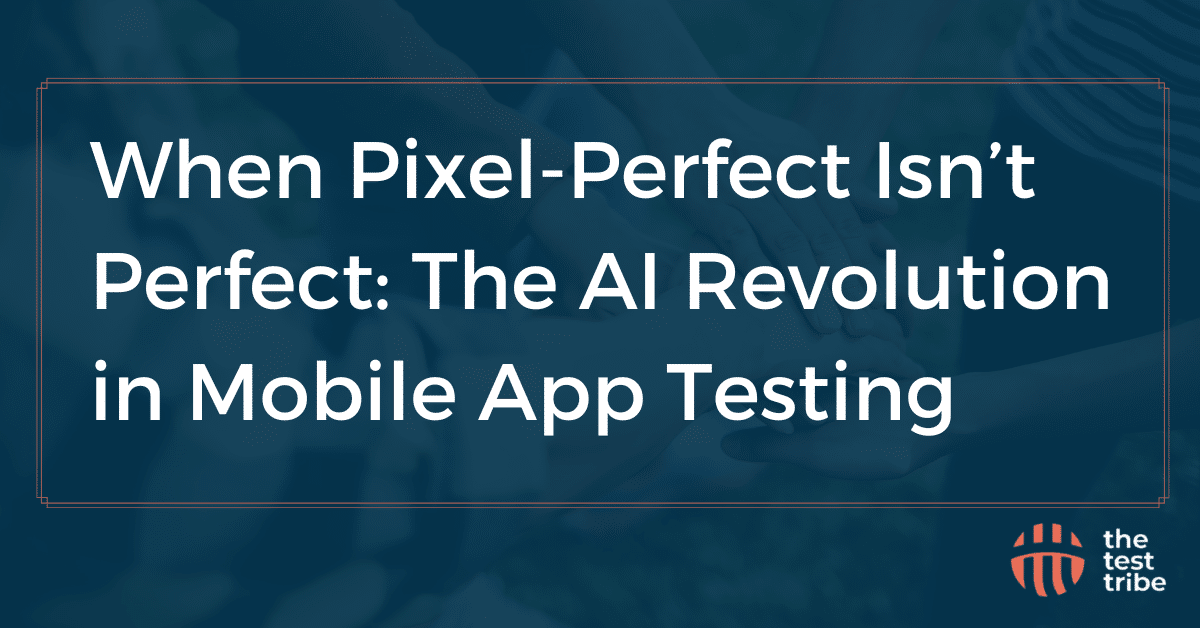When Pixel-Perfect Isn’t Perfect: The AI Revolution in Mobile App Testing
I’ve always been fascinated by how mobile test automation has evolved. From the early days of scripting interactions in Appium, Espresso, XCUITest, or any other tool, automation has come a long way in validating mobile app functionality. But there’s still one tricky area—visual validation.
Functional automation does a great job of checking whether elements exist, buttons are clickable, and text fields accept input. But just because a button is clickable doesn’t mean it’s visible or correctly placed. A misaligned button, an overlapped image, or a font rendering issue can go completely unnoticed by traditional automation scripts.
At first, pixel-to-pixel image comparison seemed like a great way to catch these issues. Capture a reference image, compare it with the current UI, and highlight any differences. Simple, right? But when I started looking into this approach, it quickly became clear that things weren’t so straightforward.
Minor differences—like anti-aliasing effects, small shifts in positioning, or even subtle color changes—kept getting flagged as failures. False positives became a constant headache. Instead of catching meaningful UI bugs, these comparisons were often highlighting things that didn’t actually impact usability. The sheer volume of noise made it difficult to focus on real issues. If a test was constantly failing for reasons that weren’t relevant, was it really adding value? Clearly, a smarter approach was needed.
That’s when I started exploring AI-powered visual testing for mobile apps.
Instead of blindly comparing pixels, AI-driven Computer Vision models take a more human-like approach to image comparison. Rather than asking “Are these images identical?”, AI-based methods analyze UI changes in context and ask, “Does this difference actually affect usability?”
One AI-powered approach that intrigued me was Visual AI, which tools like Applitools use to detect meaningful UI differences. Unlike pixel-matching, Visual AI understands layout shifts, missing elements, and component changes, making it more reliable for real-world UI testing. Instead of flagging minor variations that don’t impact usability, it focuses on real changes that could affect user experience.
But AI-driven visual testing doesn’t have to come from a third-party tool. There are ways to build a similar approach using open-source AI models and computer vision techniques.
I explored how Vision Transformers (ViTs) and Convolutional Neural Networks (CNNs) can be integrated with Large Language Models (LLMs) like Claude, Gemini, GPT-4, and LLaMA to enhance mobile UI validation.
- ViTs and CNNs are deep learning models specialized in image recognition. They process UI screenshots to detect layout shifts, missing elements, and inconsistent designs across different mobile screens.
- LLMs (Claude, Gemini, GPT-4, LLaMA) don’t process images directly but interpret the detected UI changes, classify them based on severity, and generate insights in natural language.
- This integration allows AI to not just detect UI issues but also explain them, making it easier to analyze test failures.
In a mobile testing workflow with Appium, Espresso, XCUITest, or Playwright for mobile, this integration can work like this:
1. A Vision Transformer detects that a button has moved 5 pixels down and resized by 10%.
2. The LLM reviews the change and determines if it violates accessibility or UI guidelines.
3. If it’s a critical issue, the LLM automatically updates the test scripts to accommodate the UI update.
Aside from deep learning, other image-processing techniques still play an important role. Some of the approaches I found useful include:
1. Deep Learning Models (Vision Transformers and CNNs)
- ViTs (Vision Transformers) and CNNs (Convolutional Neural Networks) process UI images to detect layout shifts, missing elements, and inconsistencies across different screens.
- These models learn UI structures, making them ideal for handling dynamic and complex interfaces in mobile apps.
2. Structural Similarity Index (SSIM)
- Instead of checking pixel-by-pixel, SSIM evaluates structural differences in images.
- This helps in identifying real UI shifts while ignoring minor rendering variations like shading or font smoothing.
3. Feature Matching (ORB, SIFT)
- These traditional computer vision techniques detect key visual points in UI screenshots.
- Useful for handling different screen sizes, resolutions, and slightly modified UI elements.
What stood out the most was that these AI-powered techniques weren’t just theoretical—they could be integrated into mobile test automation frameworks, whether Appium, Espresso, XCUITest, Playwright for mobile, or any other tool. Combining AI-based image analysis with traditional automation makes it possible to create tests that validate functionality and appearance in a single run.
Visual issues can slip through traditional automation, and pixel-based image comparison alone isn’t reliable enough. But AI-powered visual testing—whether through tools like Applitools or custom AI models like Vision Transformers, CNNs, Claude, Gemini, and LLaMA—provides a smarter, more adaptable approach to mobile UI validation.
I’d love to hear from others in the mobile testing community. Have you explored AI-driven visual validation? Have you ever encountered a UI bug that slipped through functional automation? Let’s discuss!









